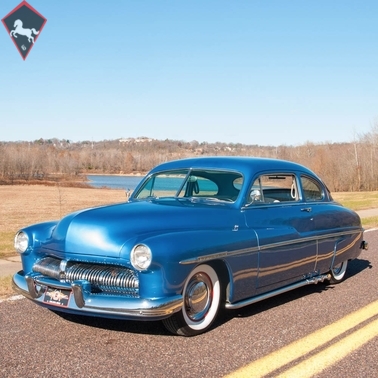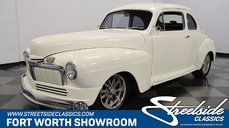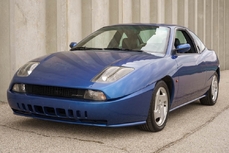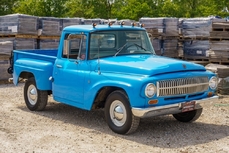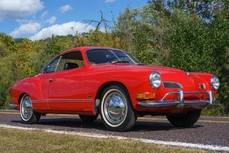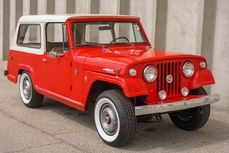Mercury Coupe V8 1950
General description :
1950 Mercury Eight Coupe
Second-to-last year for Mercurys original nameplate
Car originally made at Fords Hazelwood, Missouri assembly plant
Custom blue exterior and pastel gray/dark gray interior
255 CID flathead V-8 engine with Offenhauser aluminum heads and intake manifold and dual carburetors
Three-speed on the floor manual transmission
Dual exhaust and triple-exit side pipes
Vintage air conditioning
Power steering, power brakes, tilt and chromed steering column
Frenched headlights
Digital instrument panel
Wide whitewall radials and rear wheels skirts
Mercurys always represented a step up from the Ford models on which theyre based and this particular car has been taken beyond what any stock post-war Mercury offered. Here at MotoeXotica Classic Cars, were proud to offer this custom 1950 Mercury Eight Coupe that is still powered by a gorgeous 255CID Ford Flathead V8!
This car started life at Fords Hazelwood, Missouri assembly plant, which was relatively new itself in 1950. This cars custom blue paint is brilliant and in excellent overall condition, as is its chrome trim. The only minor paint blemishes are near the fuel filler door, on the drivers side where the hood and fender meet and on the drivers side cowl. The cars lights are in near perfect order and the car rides on wide whitewall radials surrounding full moon hubcaps. This cars body panels are solid and straight, as are its bumpers. Car includes rear wheel skirts. The trunk is finished to a high degree with gray carpet and lighter gray front and side panels and includes a full-size spare tire. The engine bay that houses the Flathead V8 is very tidy.
Under the hood is a 255 CID flathead V-8 engine with Offenhauser aluminum heads and intake manifold and dual carburetors. The engine breathes through dual exhausts. Linked to the engine is a three-speed manual transmission on the floor. Driver assistance features include vintage air-conditioning that reportedly still blows cold air, power steering, power brakes and tilt steering. Currently the parking brake is inoperable.
Inside is a stunning pastel gray interior with stitched cloth bench seats fore and aft, a dark gray carpet, a headliner done in the same pastel gray as the seats and a silver metal dashboard that is complete with digital gauges, all in excellent condition. Theres a four-spoke aftermarket billet steering wheel and chromed steering column with tilt that fits the interiors vibe. The door panels, mirror glass and shift lever are in very good shape and there is no radio in this example.
The firstpostwarMercury was introduced in the 1949 model year. The engine was aflatheadV8that produced slightly more power than the then also newly designed1949 Ford. A new overdrive system was optional, activated by a handle under the dash. The styling of the Mercury Eight, when it was released in 1949, adopted the “ponton” appearance, and was successful in both ending the monotony of warmed-over pre-war style, and differentiating Mercury from its comparable Ford cousin, a trick that spelled sales success. Sales figures for both Ford and Mercury broke records in 1949. The new approach to styling was also evident on the completely redesignedLincolnand the all-newLincoln Cosmopolitan. The Mercury Eight used full instrumentation. An eight-tube radio was an option.
Within its era and beyond, the Mercury Eight was popular with customizers. In 1949,Sam Barrisbuilt the firstlead sledfrom a 1949 Mercury Eight; the Eight became the definitive lead sled, much as theFord V-8(as the“deuce”) was becoming the definitivehot rod. The Eights were among the first models to receive an aftermarketOHVengine swap, sinceOldsmobileandCadillacdeveloped the first high-compression OHV V8 engines in 1949, whereas Ford was still using a sidevalve engine. Sam and George Barris also used the 1949 body style to build “the most famous custom car ever,”theHirohata Merc, for customer Bob Hirohata in 1953. Setting a style and an attitude, it had a “momentous effect” on custom car builders,appeared in several magazines at the time and reappeared numerous times since, earning an honorable mention onRod & Custom’s “Twenty Best of All Time” list in 1991.The Eight remains a very popular subject for car modelers.
In 1950, a high-end two-doorMontereycoupe was introduced in the same vein as theFord Crestliner, theLincolnLidocoupe and theLincoln CosmopolitanCapricoupe in order to compete with the
hardtop coupesGeneral Motors introduced the previous model year. The front suspension was independent with stabilizer bars.[
This car is currently located at our facility in St. Louis, Missouri. Current mileage on the odometer shows 3,171 miles. It is sold as is, where is, on a clean and clear, mileage exempt title. GET OUT AND DRIVE!!!
CLICK HERE TO VIEW OUR YOUTUBE VIDEO
VIN: 50SL17492M
http://www.motoexotica.com/inventory/listing/1950-mercury-coupe-2/
1950 Mercury Coupe V8 is listed sold on ClassicDigest in Fenton (St. Louis) by for Not priced.
Car Facts
Car type : Car Make : Mercury Model : Coupe Model Version : V8 Engine size : 0.0 Model Year : 1950 Sub type : Coupé Location : Fenton (St. Louis)
Sold
Seller Information
Sold
People who viewed this Mercury Coupe also viewed similar Mercury listed at ClassicDigest
Other cars listed for sale by this dealer
About Mercury
Mercury, the automotive brand, has a rich history that extends beyond its role in the customization and hot-rodding scene, particularly with the iconic Mercury Eight. Here are some key points to know about Mercury:Formation and Early Years:
Mercury was introduced by the Ford Motor Company in 1938 as a mid-priced brand, positioned between the affordable Ford models and the luxury Lincoln lineup. The brand aimed to fill the gap between these two segments.
Mercury Eight:
The Mercury Eight, launched in 1939, is perhaps the most famous model in the brand's history. It featured a sleek design and a powerful V8 engine. This model became popular for customization and hot-rodding, earning it a significant place in American automotive culture.
Customization Culture:
The Mercury Eight, with its distinctive styling and relatively affordable price, became a favorite among custom car builders. It played a pivotal role in the development of the custom car and hot rod culture, particularly in the post-World War II era.
Lead Sleds and Customization:
The term "lead sled" is often associated with heavily customized cars from the 1940s and 1950s. These cars, including the Mercury Eight, were often modified with lowered suspensions, chopped roofs, and other stylistic changes. Lead sleds were a prominent part of the custom car scene, and the Mercury Eight was a popular choice for such modifications.
Post-War Prosperity:
In the post-World War II period, Mercury, like many other American automakers, experienced a surge in popularity as the economy boomed. The brand contributed to the era's fascination with stylish and powerful automobiles.
Evolution of Models:
Over the years, Mercury continued to produce various models, contributing to Ford's lineup. Some notable models include the Mercury Monterey, Mercury Comet, and Mercury Cougar.
Decline and Discontinuation:
Despite periods of success, Mercury faced challenges in establishing a unique identity separate from Ford. As consumer preferences shifted, the brand struggled, and Ford eventually announced the discontinuation of Mercury in 2010.
Legacy in Popular Culture:
Mercury, especially models like the Mercury Eight, holds a significant place in American popular culture. Its association with the customization and hot-rodding scene, as well as its distinctive designs, has left a lasting impact.
In summary, while the Mercury Eight is celebrated for its role in the customization and hot-rodding subculture, Mercury as a brand played a broader role in automotive history, contributing to mid-priced segments and reflecting the automotive trends of its time.
